Kaitai Liang
LADDER: Multi-objective Backdoor Attack via Evolutionary Algorithm
Nov 28, 2024Abstract:Current black-box backdoor attacks in convolutional neural networks formulate attack objective(s) as single-objective optimization problems in single domain. Designing triggers in single domain harms semantics and trigger robustness as well as introduces visual and spectral anomaly. This work proposes a multi-objective black-box backdoor attack in dual domains via evolutionary algorithm (LADDER), the first instance of achieving multiple attack objectives simultaneously by optimizing triggers without requiring prior knowledge about victim model. In particular, we formulate LADDER as a multi-objective optimization problem (MOP) and solve it via multi-objective evolutionary algorithm (MOEA). MOEA maintains a population of triggers with trade-offs among attack objectives and uses non-dominated sort to drive triggers toward optimal solutions. We further apply preference-based selection to MOEA to exclude impractical triggers. We state that LADDER investigates a new dual-domain perspective for trigger stealthiness by minimizing the anomaly between clean and poisoned samples in the spectral domain. Lastly, the robustness against preprocessing operations is achieved by pushing triggers to low-frequency regions. Extensive experiments comprehensively showcase that LADDER achieves attack effectiveness of at least 99%, attack robustness with 90.23% (50.09% higher than state-of-the-art attacks on average), superior natural stealthiness (1.12x to 196.74x improvement) and excellent spectral stealthiness (8.45x enhancement) as compared to current stealthy attacks by the average $l_2$-norm across 5 public datasets.
Low-Frequency Black-Box Backdoor Attack via Evolutionary Algorithm
Mar 06, 2024Abstract:While convolutional neural networks (CNNs) have achieved success in computer vision tasks, it is vulnerable to backdoor attacks. Such attacks could mislead the victim model to make attacker-chosen prediction with a specific trigger pattern. Until now, the trigger injection of existing attacks is mainly limited to spatial domain. Recent works take advantage of perceptual properties of planting specific patterns in the frequency domain, which only reflect indistinguishable pixel-wise perturbations in pixel domain. However, in the black-box setup, the inaccessibility of training process often renders more complex trigger designs. Existing frequency attacks simply handcraft the magnitude of spectrum, introducing anomaly frequency disparities between clean and poisoned data and taking risks of being removed by image processing operations (such as lossy compression and filtering). In this paper, we propose a robust low-frequency black-box backdoor attack (LFBA), which minimally perturbs low-frequency components of frequency spectrum and maintains the perceptual similarity in spatial space simultaneously. The key insight of our attack restrict the search for the optimal trigger to low-frequency region that can achieve high attack effectiveness, robustness against image transformation defenses and stealthiness in dual space. We utilize simulated annealing (SA), a form of evolutionary algorithm, to optimize the properties of frequency trigger including the number of manipulated frequency bands and the perturbation of each frequency component, without relying on the knowledge from the victim classifier. Extensive experiments on real-world datasets verify the effectiveness and robustness of LFBA against image processing operations and the state-of-the-art backdoor defenses, as well as its inherent stealthiness in both spatial and frequency space, making it resilient against frequency inspection.
FTA: Stealthy and Robust Backdoor Attack with Flexible Trigger on Federated Learning
Aug 31, 2023Abstract:Current backdoor attacks against federated learning (FL) strongly rely on universal triggers or semantic patterns, which can be easily detected and filtered by certain defense mechanisms such as norm clipping, comparing parameter divergences among local updates. In this work, we propose a new stealthy and robust backdoor attack with flexible triggers against FL defenses. To achieve this, we build a generative trigger function that can learn to manipulate the benign samples with an imperceptible flexible trigger pattern and simultaneously make the trigger pattern include the most significant hidden features of the attacker-chosen label. Moreover, our trigger generator can keep learning and adapt across different rounds, allowing it to adjust to changes in the global model. By filling the distinguishable difference (the mapping between the trigger pattern and target label), we make our attack naturally stealthy. Extensive experiments on real-world datasets verify the effectiveness and stealthiness of our attack compared to prior attacks on decentralized learning framework with eight well-studied defenses.
BRIEF but Powerful: Byzantine-Robust and Privacy-Preserving Federated Learning via Model Segmentation and Secure clustering
Aug 22, 2022
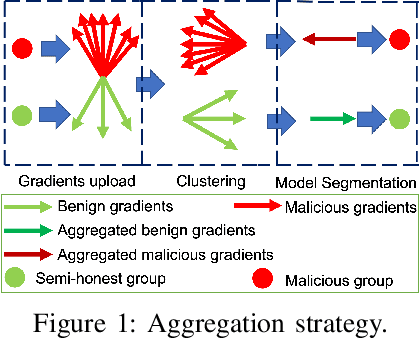
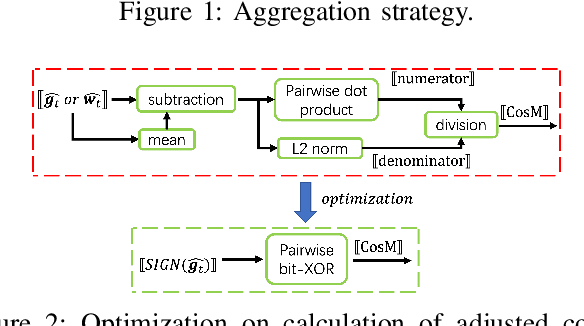
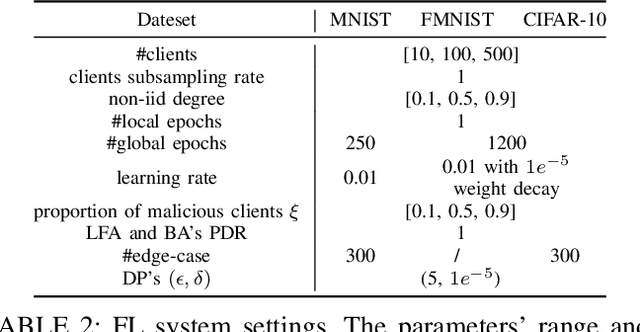
Abstract:Byzantine-robust Federated Learning (FL) aims to counter malicious clients and to train an accurate global model while maintaining an extremely low attack success rate. Most of the existing systems, however, are only robust in honest/semi-honest majority settings. FLTrust (NDSS '21) extends the context to the malicious majority for clients but with a strong restriction that the server should be provided with an auxiliary dataset before training in order to filter malicious inputs. Private FLAME/FLGUARD (USENIX '22) gives a solution to guarantee both robustness and updates confidentiality in the semi-honest majority context. It is so far impossible to balance the trade-off among malicious context, robustness, and updates confidentiality. To tackle this problem, we propose a novel Byzantine-robust and privacy-preserving FL system, called BRIEF, to capture malicious minority and majority for server and client sides. Specifically, based on the DBSCAN algorithm, we design a new method for clustering via pairwise adjusted cosine similarity to boost the accuracy of the clustering results. To thwart attacks of malicious majority, we develop an algorithm called Model Segmentation, where local updates in the same cluster are aggregated together, and the aggregations are sent back to corresponding clients correctly. We also leverage multiple cryptographic tools to conduct clustering tasks without sacrificing training correctness and updates confidentiality. We present detailed security proof and empirical evaluation along with convergence analysis for BRIEF. The experimental results demonstrate that the testing accuracy of BRIEF is practically close to the FL baseline (0.8% gap on average). At the same time, the attack success rate is around 0%-5%. We further optimize our design so that the communication overhead and runtime can be decreased by {67%-89.17% and 66.05%-68.75%}, respectively.
Effect of Homomorphic Encryption on the Performance of Training Federated Learning Generative Adversarial Networks
Jul 01, 2022



Abstract:A Generative Adversarial Network (GAN) is a deep-learning generative model in the field of Machine Learning (ML) that involves training two Neural Networks (NN) using a sizable data set. In certain fields, such as medicine, the training data may be hospital patient records that are stored across different hospitals. The classic centralized approach would involve sending the data to a centralized server where the model would be trained. However, that would involve breaching the privacy and confidentiality of the patients and their data, which would be unacceptable. Therefore, Federated Learning (FL), an ML technique that trains ML models in a distributed setting without data ever leaving the host device, would be a better alternative to the centralized option. In this ML technique, only parameters and certain metadata would be communicated. In spite of that, there still exist attacks that can infer user data using the parameters and metadata. A fully privacy-preserving solution involves homomorphically encrypting (HE) the data communicated. This paper will focus on the performance loss of training an FL-GAN with three different types of Homomorphic Encryption: Partial Homomorphic Encryption (PHE), Somewhat Homomorphic Encryption (SHE), and Fully Homomorphic Encryption (FHE). We will also test the performance loss of Multi-Party Computations (MPC), as it has homomorphic properties. The performances will be compared to the performance of training an FL-GAN without encryption as well. Our experiments show that the more complex the encryption method is, the longer it takes, with the extra time taken for HE is quite significant in comparison to the base case of FL.
Using Autoencoders on Differentially Private Federated Learning GANs
Jun 24, 2022



Abstract:Machine learning has been applied to almost all fields of computer science over the past decades. The introduction of GANs allowed for new possibilities in fields of medical research and text prediction. However, these new fields work with ever more privacy-sensitive data. In order to maintain user privacy, a combination of federated learning, differential privacy and GANs can be used to work with private data without giving away a users' privacy. Recently, two implementations of such combinations have been published: DP-Fed-Avg GAN and GS-WGAN. This paper compares their performance and introduces an alternative version of DP-Fed-Avg GAN that makes use of denoising techniques to combat the loss in accuracy that generally occurs when applying differential privacy and federated learning to GANs. We also compare the novel adaptation of denoised DP-Fed-Avg GAN to the state-of-the-art implementations in this field.
MULTI-FLGANs: Multi-Distributed Adversarial Networks for Non-IID distribution
Jun 24, 2022



Abstract:Federated learning is an emerging concept in the domain of distributed machine learning. This concept has enabled GANs to benefit from the rich distributed training data while preserving privacy. However, in a non-iid setting, current federated GAN architectures are unstable, struggling to learn the distinct features and vulnerable to mode collapse. In this paper, we propose a novel architecture MULTI-FLGAN to solve the problem of low-quality images, mode collapse and instability for non-iid datasets. Our results show that MULTI-FLGAN is four times as stable and performant (i.e. high inception score) on average over 20 clients compared to baseline FLGAN.
FLVoogd: Robust And Privacy Preserving Federated Learning
Jun 24, 2022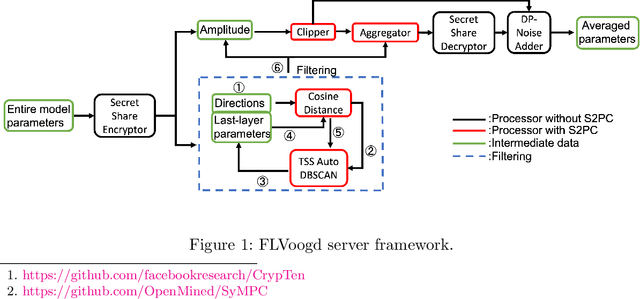


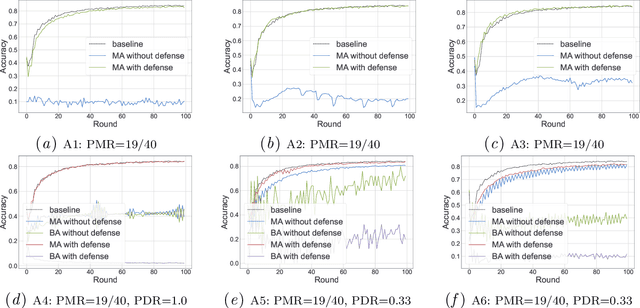
Abstract:In this work, we propose FLVoogd, an updated federated learning method in which servers and clients collaboratively eliminate Byzantine attacks while preserving privacy. In particular, servers use automatic Density-based Spatial Clustering of Applications with Noise (DBSCAN) combined with S2PC to cluster the benign majority without acquiring sensitive personal information. Meanwhile, clients build dual models and perform test-based distance controlling to adjust their local models toward the global one to achieve personalizing. Our framework is automatic and adaptive that servers/clients don't need to tune the parameters during the training. In addition, our framework leverages Secure Multi-party Computation (SMPC) operations, including multiplications, additions, and comparison, where costly operations, like division and square root, are not required. Evaluations are carried out on some conventional datasets from the image classification field. The result shows that FLVoogd can effectively reject malicious uploads in most scenarios; meanwhile, it avoids data leakage from the server-side.
More is Better : On the Backdoor Attacks in Federated Graph Neural Networks
Feb 07, 2022



Abstract:Graph Neural Networks (GNNs) are a class of deep learning-based methods for processing graph domain information. GNNs have recently become a widely used graph analysis method due to their superior ability to learn representations for complex graph data. However, due to privacy concerns and regulation restrictions, centralized GNNs can be difficult to apply to data-sensitive scenarios. Federated learning (FL) is an emerging technology developed for privacy-preserving settings when several parties need to train a shared global model collaboratively. Although many research works have applied FL to train GNNs (Federated GNNs), there is no research on their robustness to backdoor attacks. This paper bridges this gap by conducting two types of backdoor attacks in Federated GNNs: centralized backdoor attacks (CBA) and distributed backdoor attacks (DBA). CBA is conducted by embedding the same global trigger during training for every malicious party, while DBA is conducted by decomposing a global trigger into separate local triggers and embedding them into the training dataset of different malicious parties, respectively. Our experiments show that the DBA attack success rate is higher than CBA in almost all evaluated cases, while rarely, the DBA attack performance is close to CBA. For CBA, the attack success rate of all local triggers is similar to the global trigger even if the training set of the adversarial party is embedded with the global trigger. To further explore the properties of two backdoor attacks in Federated GNNs, we evaluate the attack performance for different trigger sizes, poisoning intensities, and trigger densities, with trigger density being the most influential.
HoneyCar: A Framework to Configure HoneypotVulnerabilities on the Internet of Vehicles
Nov 03, 2021
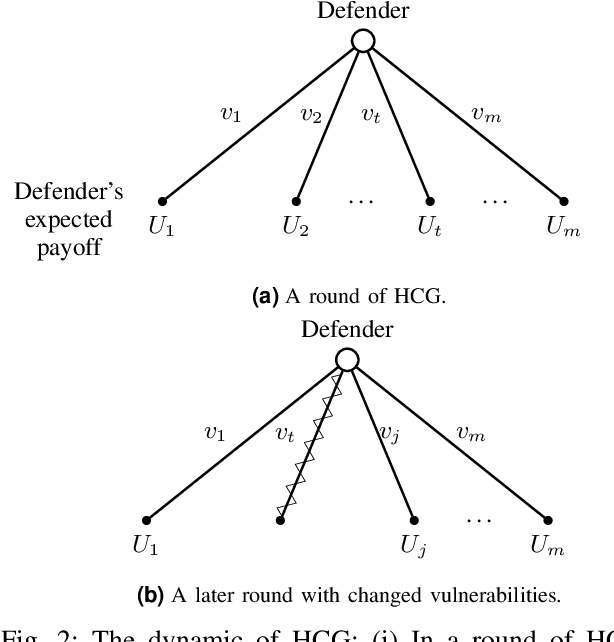
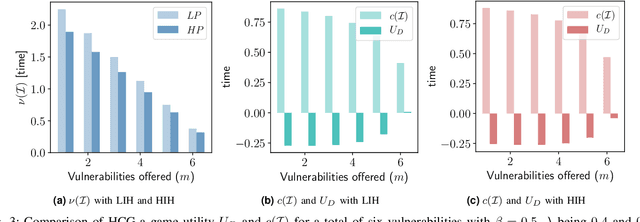
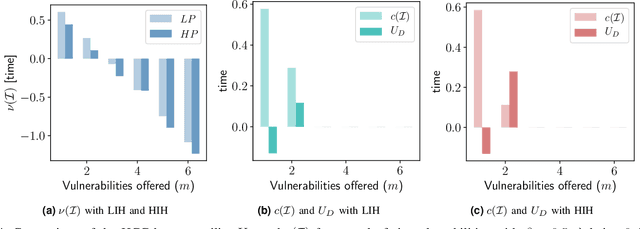
Abstract:The Internet of Vehicles (IoV), whereby interconnected vehicles communicate with each other and with road infrastructure on a common network, has promising socio-economic benefits but also poses new cyber-physical threats. Data on vehicular attackers can be realistically gathered through cyber threat intelligence using systems like honeypots. Admittedly, configuring honeypots introduces a trade-off between the level of honeypot-attacker interactions and any incurred overheads and costs for implementing and monitoring these honeypots. We argue that effective deception can be achieved through strategically configuring the honeypots to represent components of the IoV and engage attackers to collect cyber threat intelligence. In this paper, we present HoneyCar, a novel decision support framework for honeypot deception in IoV. HoneyCar builds upon a repository of known vulnerabilities of the autonomous and connected vehicles found in the Common Vulnerabilities and Exposure (CVE) data within the National Vulnerability Database (NVD) to compute optimal honeypot configuration strategies. By taking a game-theoretic approach, we model the adversarial interaction as a repeated imperfect-information zero-sum game in which the IoV network administrator chooses a set of vulnerabilities to offer in a honeypot and a strategic attacker chooses a vulnerability of the IoV to exploit under uncertainty. Our investigation is substantiated by examining two different versions of the game, with and without the re-configuration cost to empower the network administrator to determine optimal honeypot configurations. We evaluate HoneyCar in a realistic use case to support decision makers with determining optimal honeypot configuration strategies for strategic deployment in IoV.
 Add to Chrome
Add to Chrome Add to Firefox
Add to Firefox Add to Edge
Add to Edge